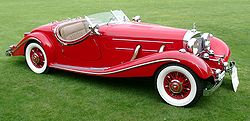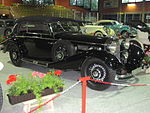- Mercedes-Benz 540K
-
Mercedes-Benz 540K 
Manufacturer Mercedes-Benz Production 1936–1940 (chassis -- last bodies completed in 1944) Assembly Untertürkheim factory, Sindelfingen, Germany Predecessor Mercedes-Benz 500K Successor Mercedes-Benz 580K (Prototype only) Body style two seater cabriolet
four seater coupé
seven seater limousineLayout Front-engine, rear-wheel drive Engine 5,401 cc straight-8 Transmission 4-speed or optional 5-speed manual[1] Wheelbase 2,980 mm (117.3 in) (SWB)
3,290 mm (129.5 in) (Normal)
3,880 mm (152.8 in) (Special)Curb weight Up to 2,700 kg (6,000 lb) Designer Friedrich Geiger Mercedes-Benz 540K (type W24) is a car from the German firm Mercedes-Benz from 1935 to 1940.
Contents
Creation
Introduced at the 1936 Paris Motor Show, the Friedrich Geiger designed car was a development to the 500K, itself a development of the SSK. Available as a two seater cabriolet, four seater coupé or seven seater limousine with armoured sides and armoured glass, it was one of the largest cars of the time.
The straight-8 cylinder engine of the 500K was increased to 5.401 litres (5,401 cc), which aspirated by twin pressurized updraft carburetors, developed a natural 115 hp (86 kW). However, there was an attached Roots supercharger which could either be engaged manually for short periods, or automatically when the accelerator was pushed fully to the floor. This increased power to 180 hp (130 kW), creating a top speed of 170 kilometres per hour (110 mph).[2]
Power was sent to the rear wheels through a four-speed or optional five speed manual gearbox that featured synchromesh on the top three gears. Vacuum-assisted hydraulic brakes kept the car under the drivers control.
The 540K had the same chassis layout at the 500K, but was significantly lightened by replacing the girder-like frame of the 500K with oval-section tubes - an influence of the Silver Arrows racing campaign.[3]
To meet individual wishes of customers, three chassis variants were available as for the 500K: two long versions with a 3,290 mm (130 in) wheelbase, differing in terms of powertrain and bodywork layout; and a short version with 2,980 mm (117 in). The long variant, termed the normal chassis with the radiator directly above the front axle, served as the backbone for the four-seater cabriolets 'B' (with four side windows) and 'C' (with two side windows), and for touring cars and sedans. The shorter chassis was for the two-seater cabriolet 'A,' set up on a chassis on which radiator, engine, cockpit and all rearward modules[clarification needed] were moved 185 mm (7.3 in) back from the front axle.[4]
The Sindelfingen factory employed 1,500 people to create the 540K, and allowed a great deal of owner customisation, meaning only 70 chassis were ever bodied by independent builders.[2] Owners included Jack Warner of Warner Brothers film studios.[5]
With the outbreak of World War II in 1939, the proposed further boring-out of the engine to 5,800 cubic centimetres (5.8 l) for a 580K was aborted, probably after only one such car was made.[3] Chassis production ceased in 1940, with the final 2 being completed that year, and earlier chassis were still being bodied at a steady rate during 1940, with smaller numbers being completed in the 1941–1943 period. Regular replacement bodies were ordered in 1944 for a few cars.
Special saloon
On top of the normal and roadster cars, 12 special cars were developed on an extended chassis length with a 3,880 mm (153 in) wheelbase. All of these cars were developed for the Nazi hierarchy, as six seater convertible saloons. To allow for armour plate, these cars had developed De Dion rear suspension. Due to their higher weight, their maximum speed was 140 km/h (87 mph).
After the assassination attempt on Reinhard Heydrich in Prague at the end of May 1942, the Reich Chancellery would only use armoured cars for ministers and leaders of friendly powers. Beside 20 large Mercedes-Benz 770s, in 1942 they ordered an additional 20 540Ks developed as two door armoured saloons. These were delivered during 1942 and 1943. A further order for 17 armored saloons was placed in late 1943, and these were delivered in April 1944. One of these cars was given as a gift from Adolf Hitler to Ante Pavelić, leader of the Independent State of Croatia. After the war this car was captured and used first by Ivan Krajacic, and then by Josip Broz Tito.
Blue Goose
In 1936, Mercedes-Benz launched the 540K special, designated 540Ks. Based on the shorter 2,980 mm (117 in) wheelbase chassis, its body was carefully crafted. Its price tag of 28,000 Reichsmarks, some RM6,000 above the price of standard models, meant only 32 were ever built.[4]
In 1937, Reichsmarschall Hermann Göring ordered a 540Ks, in his favourite colour of blue with his family crest on both doors. It included armour plated sides and bulletproof glass. Nicknamed the Blue Goose, Goering was often photographed in the car.[4][5]
On May 4, 1945, the US Army, C Company, 326th Engineers, 101st Airborne Division 'Screaming Eagles' entered Berchtesgaden, and on finding the car took possession. Major General Maxwell Taylor used the car as his command vehicle in West Germany until it was commissioned by the US Treasury. Shipped to Washington, D.C., it successfully toured the United States in a victory bond tour.[4] In 1956 the car was auctioned off by the US Army at the Aberdeen Proving Grounds in Maryland, sold to Jacques Tunick of Greenwich, Connecticut, with a high bid of $2167.[6]
In 1958, he sold it to the private collection of veterinarian Dr George Bitgood, Jr, who had it repainted into black and the chrome re plated. Kept private, Bitgood only displayed it once at the 1973 county fair in Durham, Connecticut. After Dr Bitgood's death, Blue Goose was shown by his family at the 101st Airborne Reunion at Fort Campbell, Kentucky in June, 2002. She was then sold to Carnlough International Limited of Guernsey, on the agreement that she be restored to her "as found" at Berchtesgaden condition.[6]
Production
Combined production of the 500K (342 cars) and 540K (419 cars) from Sindelfingen, deliveries were:
- 70 chassis without body
- 28 open cars
- 23 sedans with 4 doors (mainly 500K)
- 29 sedans with 2 doors (mainly 540K)
- 12 Coupés
- 6 Autobahn cruisers
- 58 Roadsters
- 116 Cabriolets A
- 296 Cabriolets B
- 122 Cabriolets C
Gallery
-
1938 Mercedes-Benz 540k Special Roadster at Auto & Technik Museum, Sinsheim
-
1937 Mercedes-Benz 540K Cabriolet B at Mercedes-Benz Museum, Stuttgart
References
- ^ "1934 - The Mercedes 500K is born". Classicdriver.com. http://www.classicdriver.com/uk/magazine/3200.asp?id=11919.
- ^ a b "Mercedes-Benz 540K". Concept Carz. http://www.conceptcarz.com/vehicle/z9097/Mercedes-Benz-540K.aspx. Retrieved 2010-01-08.
- ^ a b Brian Sewell (2007-04-12). "Mercedes-Benz 540K". London: The Independent. http://www.independent.co.uk/life-style/motoring/classic-cars/mercedesbenz-540k-484114.html. Retrieved 2010-01-08.
- ^ a b c d "Mercedes-Benz 540K special". Concept Carz. http://www.conceptcarz.com/vehicle/z9096/Mercedes-Benz-540K-Special.aspx. Retrieved 2010-01-08.
- ^ a b Jones, Sam (2007-10-31). "World's richest classic car collectors roll up for Ecclestone's garage sale". London: The Guardian. http://www.guardian.co.uk/uk/2007/oct/31/uknews4.mainsection. Retrieved 2010-01-08.
- ^ a b "The Extraordinary story of Hermann Göring's 540K". Literary Club. http://google.com/search?q=cache:v7MYWEHN_TAJ:www.literaryclub.org/sitebuildercontent/sitebuilderfiles/The_Saga_of_the_Blue_Goose-Maley.doc+blue+goose+mercedes&cd=4&hl=en&ct=clnk&gl=uk&client=firefox-a. Retrieved 2010-01-08.
« DMG/Mercedes road car timeline — « Benz road car timeline — Mercedes-Benz road car timeline, 1926–1944 — next »
Class 1920s 1930s 1940s 6 7 8 9 0 1 2 3 4 5 6 7 8 9 0 1 2 3 4 Small car W23 W28 Small family car W15 W136 Family car 10/35 W02 W21 W143 W11 W153 W138 Large family car 16/50 W03 W10 W18 W142 Large car 400 W08 Luxury car 630 W07 W150 W22 W29 / W24 Sports car W06 Categories:- Mercedes-Benz vehicles
- 1930s automobiles
- Vehicles introduced in 1935
Wikimedia Foundation. 2010.







